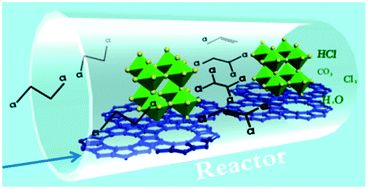Catalytic removal of 1,2-dichloroethane over LaSrMnCoO6/H-ZSM-5 composite: insights into synergistic effect and pollutant-destruction mechanism†
Abstract
LaxSr2−xMnCoO6 materials with different Sr contents were prepared by a coprecipitation method, with LaSrMnCoO6 found to be the best catalyst for 1,2-dichloroethane (DCE) destruction (T90 = 509 °C). As such, a series of LaSrMnCoO6/H-ZSM-5 composite materials were rationally synthesized to further improve the catalytic activity of LaSrMnCoO6. As expected, the introduction of H-ZSM-5 could remarkably enlarge the surface area, increase the number of Lewis acid sites, and enhance the mobility of the surface adsorbed oxygen species, which consequently improved the catalytic activity of LaSrMnCoO6. Among all the composite materials, 10 wt% LaSrMnCoO6/H-ZSM-5 possessed the highest catalytic activity, with 90% of 1,2-DCE destructed at 337 °C, which is a temperature reduction of more than 70 °C and 170 °C compared with that of H-ZSM-5 (T90 = 411 °C) and LaSrMnCoO6 (T90 = 509 °C), respectively. Online product analysis revealed that CO2, CO, HCl, and Cl2 were the primary products in the oxidation of 1,2-DCE, while several unfavorable reaction by-products, such as vinyl chloride, 1,1,2-trichloroethane, trichloroethylene, perchloroethylene, and acetaldehyde, were also formed via dechlorination and dehydrochlorination processes. Based on the above results, the reaction path and mechanism of 1,2-DCE decomposition are proposed.



 Please wait while we load your content...
Please wait while we load your content...